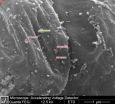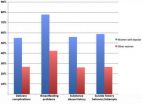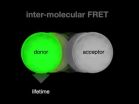(Press-News.org) In a surprising new finding, researchers have discovered that bacterial movement is impeded in flowing water, enhancing the likelihood that the microbes will attach to surfaces. The new work could have implications for the study of marine ecosystems, and for our understanding of how infections take hold in medical devices.
The findings, the result of microscopic analysis of bacteria inside microfluidic devices, were made by MIT postdoc Roberto Rusconi, former MIT postdoc Jeffrey Guasto (now an assistant professor of mechanical engineering at Tufts University), and Roman Stocker, an associate professor of civil and environmental engineering at MIT. Their results are published in the journal Nature Physics.
The study, which combined experimental observations with mathematical modeling, showed that the flow of liquid can have two significant effects on microbes: "It quenches the ability of microbes to chase food," Stocker says, "and it helps microbes find surfaces."
That second finding could be particularly beneficial: Stocker says in some cases, that phenomenon could lead to new approaches to tuning flow rates to prevent fouling of surfaces by microbes — potentially averting everything from bacteria getting a toehold on medical equipment to biofilms causing drag on ship hulls.
The effect of flowing water on bacterial swimming was "a complete surprise," Stocker says.
"My own earlier predictions of what would happen when microbes swim in flowing water had been: 'Nothing too interesting,'" he adds. "It was only when Roberto and Jeff did the experiments that we found this very strong and robust phenomenon."
Even though most microorganisms live in flowing liquid, most studies of their behavior ignore flow, Stocker explains. The new findings show, he says, that "any study of microbes suspended in a liquid should not ignore that the motion of that liquid could have important repercussions on the microbes."
The novelty of this result owes partly to the divisions of academic specialties, and partly to advances in technology, Stocker says. "Microbiologists have rarely taken into account fluid flow as an ecological parameter, whereas physicists have just recently started to pay attention to microbes," he says, adding: "The ability to directly watch microbes under the controlled flow conditions afforded by microfluidic technology — which is only about 15 years old — has made all the difference in allowing us to discover and understand this effect of flow on microbes."
The team found that swimming bacteria cluster in the "high shear zones" in a flow — the regions where the speed of the fluid changes most abruptly. Such high shear zones occur in most types of flows, and in many bacterial habitats. One prominent location is near the walls of tubes, where the result is a strong enhancement of the bacteria's tendency to adhere to those walls and form biofilms.
But this effect varies greatly depending on the speed of the flow, opening the possibility that the rate of biofilm formation can be tweaked by increasing or decreasing flow rates.
Guasto says the new understanding could help in the design of medical equipment to reduce such infections: Since the phenomenon peaks at particular rates of shear, he says, "Our results might suggest additional design criteria for biomedical devices, which should operate outside this range of shear rates, when possible — either faster or slower."
"Biofilms are found everywhere," Rusconi says, adding that the majority of bacteria spend significant fractions of their lives adhering to surfaces. "They cause major problems in industrial settings," such as by clogging pipes or reducing the efficiency of heat exchangers. Their adherence is also a major health issue: Bacteria concentrated in biofilms are up to 1,000 times more resistant to antibiotics than those suspended in liquid.
The concentration of microbes in the shear zones is an effect that only happens with those that can control their movements. Nonliving particles of similar size and shape show no such effect, the team found, nor do nonmotile bacteria that are swept along passively by the water. "Without motility, bacteria are distributed everywhere and there is no preferential accumulation," Rusconi says.
The new findings could also be important for studies of microbial marine ecosystems, by affecting how bacteria move in search of nutrients when one accounts for the ubiquitous currents and turbulence, Stocker says. Though they only studied two types of bacteria, the researchers predict in their paper that "this phenomenon should apply very broadly to many different motile microbes."
In fact, the phenomenon has no inherent size limit, and could apply to a wide range of organisms, Guasto says. "There's really nothing special about bacteria compared to many other swimming cells in this respect," he says. "This phenomenon could easily apply to a wide range of plankton and sperm cells as well."
INFORMATION:
The research was supported by the National Science Foundation and by a Gordon and Betty Moore Marine Microbial Initiative Investigator award to Stocker.
Written by David Chandler, MIT News Office
Additional background
Archive: In Profile: Roman Stocker finds big effects from tiny organisms
http://web.mit.edu/newsoffice/2012/faculty-profile-stocker-civil-environmental-1213.html
Researchers find flowing water can slow down bacteria
In a surprising new discovery, scientists show that microbes are more likely to adhere to tube walls when water is moving
2014-02-24
ELSE PRESS RELEASES FROM THIS DATE:
Tip to dieters: Beware of friends and late night cravings
2014-02-24
There's more to dieting than just sheer willpower and self-control. The presence of friends, late night cravings or the temptation of alcohol can often simply be too strong to resist. Research led by Heather McKee of the University of Birmingham in the UK monitored the social and environmental factors that make people, who are following weight management programs, cheat. The study¹ is published in the Springer journal Annals of Behavioral Medicine.²
Eighty people who were either part of a weight-loss group or were dieting on their own participated in the one-week study. ...
Novel assay developed for detecting ALK rearrangement in NSCLC
2014-02-24
DENVER – Researchers have developed a novel technique for detecting ALK rearrangements in non-small cell lung cancers (NSCLCs) that is more sensitive and easier to perform than currently available techniques. The technique can help enhance the routine practice of diagnostic ALK testing on NSCLCs, which is crucial for identifying patients with advanced NSCLC who are most likely to benefit from targeted therapy with an ALK inhibitor.
None of the current three routine methods used to detect ALK rearrangements in NSCLC is without drawbacks, especially for tissue specimens ...
A fast and effective mechanism to combat an aggressive cancer
2014-02-24
Ovarian cancer accounts for more deaths of American women than any other cancer of the female reproductive system. According to the American Cancer Society, one in 72 American women will be diagnosed with ovarian cancer, and one in 100 will ultimately die of the condition.
Now Prof. Dan Peer of Tel Aviv University's Department of Cell Research and Immunology has proposed a new strategy to tackle an aggressive subtype of ovarian cancer using a new nanoscale drug-delivery system designed to target specific cancer cells. He and his team – Keren Cohen and Rafi Emmanuel from ...
EARTH Magazine: Tsunamis from the sky
2014-02-24
Alexandria, VA – On a beautiful, clear June morning in 1954, a massive wave suddenly swept out of Lake Michigan killing at least seven people along the Chicago waterfront. At the time, the wave was attributed to a storm that had earlier passed over northern Lake Michigan, but how it came to swamp faraway Chicago, with no warning, was not understood.
The Great Lakes, along with the Mediterranean, Japan and many other parts of the world, have a long history of such waves, which have characteristics similar to tsunamis triggered by earthquakes or landslides.
Only recently, ...
Cardiovascular Institute researcher: Cancer drug may lower sudden cardiac death risk
2014-02-24
PROVIDENCE, R.I. – A researcher at the Cardiovascular Institute (CVI) at Rhode Island, The Miriam and Newport hospitals has found that a new class of drugs, originally developed to treat cancer, reduces sudden cardiac death risk after a heart attack. The findings were published online in advance of print in the Journal of the American College of Cardiology.
"Currently, there are limited options to reduce sudden cardiac death following a heart attack," said principal investigator Samuel C. Dudley, M.D., Ph.D., chief of cardiology at the CVI. "The benefit of most drugs ...
Toxic injection with elastic band
2014-02-24
This news release is available in German.
Bacteria have developed many different ways of smuggling their toxic cargo into cells. Tripartite Tc toxin complexes, which are used by bacteria like the plague pathogen Yersinia pestis and the insect pathogen Photorhabdus luminescens, are particularly unusual. Stefan Raunser from the Max Planck Institute of Molecular Physiology in Dortmund and his colleagues from the University of Freiburg have produced extremely accurate and detailed images of these "toxic injections"; they reveal from where the molecule complexes take ...
Precursor of multiple myeloma more common in blacks than whites, Mayo study finds
2014-02-24
ROCHESTER, Minn. — Feb. 24, 2014 — Blacks may be twice as likely as whites to develop multiple myeloma because they are more likely to have a precursor condition known as monoclonal gammopathy of undetermined significance (MGUS), a Mayo Clinic study has found. Not only is MGUS more common in blacks, but the type seen in the black population is also more apt to have features associated with a higher risk of progression to full-blown multiple myeloma, a cancer of a type of white blood cell in bone marrow.
The findings, which appear in the journal Leukemia, are from the ...
Higher risks among perinatal women with bipolar disorder
2014-02-24
PROVIDENCE, R.I. [Brown University] — Pregnant and postpartum women with bipolar disorder more frequently have significant mental health and early mothering challenges than other perinatal women undergoing psychiatric treatment, according to a study in the Journal of Affective Disorders. The findings indicate the importance of properly identifying the disorder and developing specific treatments for women during and after pregnancy, the lead author said.
"Similar to what you find with bipolar disorder in the nonperinatal population, the overall level of clinical severity ...
In the eye of a chicken, a new state of matter comes into view
2014-02-24
Along with eggs, soup and rubber toys, the list of the chicken's most lasting legacies may eventually include advanced materials such as self-organizing colloids, or optics that can transmit light with the efficiency of a crystal and the flexibility of a liquid.
The unusual arrangement of cells in a chicken's eye constitutes the first known biological occurrence of a potentially new state of matter known as "disordered hyperuniformity," according to researchers from Princeton University and Washington University in St. Louis. Research in the past decade has shown that ...
Watching how the brain works
2014-02-24
Coral Gables, Fla (Feb. 19, 2014) -- There are more than a trillion cells called neurons that form a labyrinth of connections in our brains. Each of these neurons contains millions of proteins that perform different functions. Exactly how individual proteins interact to form the complex networks of the brain still remains as a mystery that is just beginning to unravel.
For the first time, a group of scientists has been able to observe intact interactions between proteins, directly in the brain of a live animal. The new live imaging approach was developed by a team of ...
LAST 30 PRESS RELEASES:
Numbers in our sights affect how we perceive space
SIMJ announces global collaborative book project in commemoration of its 75th anniversary
Air pollution exposure and birth weight
Obstructive sleep apnea risk and mental health conditions among older adults
How talking slows eye movements behind the wheel
The Ceramic Society of Japan’s Oxoate Ceramics Research Association launches new international book project
Heart-brain connection: international study reveals the role of the vagus nerve in keeping the heart young
Researchers identify Rb1 as a predictive biomarker for a new therapeutic strategy in some breast cancers
Survey reveals ethical gaps slowing AI adoption in pediatric surgery
Stimulant ADHD medications work differently than thought
AI overestimates how smart people are, according to HSE economists
HSE researchers create genome-wide map of quadruplexes
Scientists boost cell "powerhouses" to burn more calories
Automatic label checking: The missing step in making reliable medical AI
Low daily alcohol intake linked to 50% heightened mouth cancer risk in India
American Meteorological Society announces Rick Spinrad as 2026 President-Elect
Biomass-based carbon capture spotlighted in newly released global climate webinar recording
Illuminating invisible nano pollutants: advanced bioimaging tracks the full journey of emerging nanoscale contaminants in living systems
How does age affect recovery from spinal cord injury?
Novel AI tool offers prognosis for patients with head and neck cancer
Fathers’ microplastic exposure tied to their children’s metabolic problems
Research validates laboratory model for studying high-grade serous ovarian cancer
SIR 2026 delivers transformative breakthroughs in minimally invasive medicine to improve patient care
Stem Cell Reports most downloaded papers of 2025 highlight the breadth and impact of stem cell research
Oxford-led study estimates NHS spends around 3% of its primary and secondary care budget on the health impacts of heat and cold in England
A researcher’s long quest leads to a smart composite breakthrough
Urban wild bees act as “microbial sensors” of city health.
New study finds where you live affects recovery after a hip fracture
Forecasting the impact of fully automated vehicle adoption on US road traffic injuries
Alcohol-related hospitalizations from 2016 to 2022
[Press-News.org] Researchers find flowing water can slow down bacteriaIn a surprising new discovery, scientists show that microbes are more likely to adhere to tube walls when water is moving




